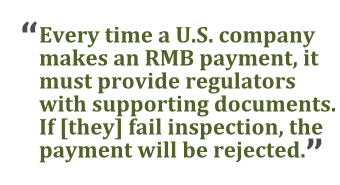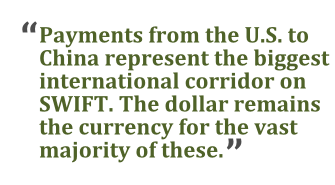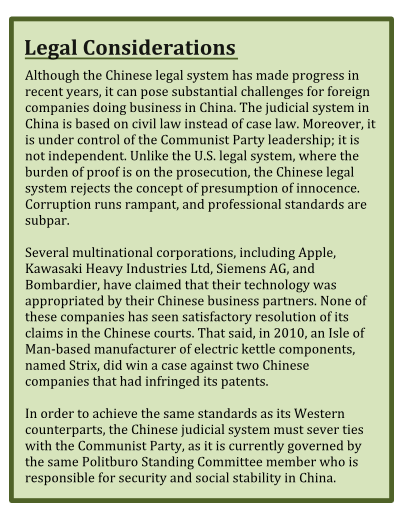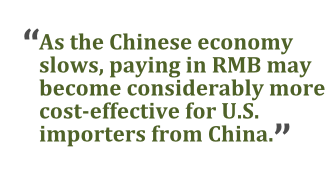Despite the spectacular economic development China hasengineered, the use of the renminbi (RMB) has not grown at the samepace as the country's industries. Many U.S. businesses that sourcefrom China continue to pay their suppliers in U.S. dollars. Doingso is convenient, and it eliminates foreign exchange (FX) risk inthose transactions. It also costs more, and it puts these companiesat a disadvantage compared with businesses that are willing totransact in RMB.
|As China has liberalized the RMB over the past decade, anincreasing number of European, Australian, and Asian companies havebegun making RMB-denominated deals. If China continues toexperience a credit squeeze and deceleration in economic growth,U.S. companies may find themselves under increasing pressure to usethe local currency when working with Chinese trading partners. Thetime is right to evaluate the pros and cons of paying and billingin RMB.
||
History of RMB Transactions
|For more than a decade, the value of the RMB was pegged to theU.S. dollar. In 2005, the People's Bank of China (PBOC)permitted the RMB to begin moving but limited its swings in valueto a maximum of 0.3 percent per day when compared with a basket ofother currencies. In 2012, the PBOC increased the RMB'strading band against the basket of currencies to 1 percent per day.Today, the value of the RMB is 25 percent higher than it was inJuly 2005.
|At the same time it began loosening the reins on the RMB'svalue, the PBOC began working directly with foreign governments toencourage use of its currency. Emerging from the global financialcrisis of 2008, Chinese President Hu Jintao calledfor “a fair, just, inclusive, and well-managed internationalfinancial order.” The PBOC began signing bilateral swap agreements(BSAs) with the central banks of other countries. Through these deals, the nations exchange aspecified quantity of RMB for the other country's currency, at aspecified exchange rate. This enables the other central bank tolend in RMB to institutions in its jurisdiction, and it enablesBeijing to encourage use of its currency abroad while maintainingquite a bit of control over foreigners' use of RMB.
|Usually this type of central bank currency swap is designed toimprove a nation's liquidity in the event of, or in order toprevent, a financial crisis. But according to the PBOC, the mainpurpose of the Chinese BSAs is to promote the use of the RMB inglobal trade and investment. To date, Beijing has signed BSAs withmore than 20 central banks, accounting for a total of more than $1trillion yuan.
|The PBOC also launched bilateral RMB clearing systems with thecentral banks of Hong Kong, Macao, Taiwan, Singapore, and theUnited Kingdom in an effort to further facilitate cross-border RMBsettlements. Going forward, it will be interesting to seewhether capital controls between China and Singapore ease furtherif Singapore develops as a source of offshore RMB liquidity.
|Current State of the Currency
|As the Chinese government has relaxed controls on the RMB, ithas reduced the barriers to RMB-denominated deals. U.S. companiesare now able to purchase RMB directly from large global banks orthrough independent foreign exchange providers. The only limitationthat the Chinese government currently places on the size of RMBsettlements involves individual Chinese citizens, who can exchangea maximum of US$50,000 per year worth of RMB for use in overseaspurchases or investments. Because there is no limit on the volumeof U.S. dollars (USD) that a Chinese citizen can move into RMB,foreign companies with operations in China may want to makepayments to individuals, such as salaries, in USD so that thoseindividuals have optimal flexibility in how they spend themoney. The PBOC has announced that it may lift even this restriction by the end ofthis year.
Nevertheless, making a cross-border payment denominated in RMBis not as simple as making a cross-border payment in USD. First, adistinction should be made between the RMB used in transactionswithin the borders of mainland China (CNY) and RMB traded offshore,mainly in Hong Kong (CNH). The CNY is the currency that stillfluctuates within a tight trading band controlled by the PBOC (1percent maximum shift per day relative to a basket of othercurrencies). The CNH, which enters FX markets via the PBOC'sbilateral swap agreements, moves freely with the market. Butbecause the PBOC tightly controls the supply of CNH, demand usuallyexceeds supply, and the CNH usually trades above the value of theCNY. Chinese companies usually convert their CNY into foreigncurrencies in Hong Kong at the more attractive CNH rate.
|Payments in mainland China that are denominated in RMB areprocessed through the China National Advanced Payment System(CNAPS). Clearing interbank payments through the system ofteninvolves manual data entry, which raises the unit cost of eachtransaction. In addition, the CNAPS clearing code is more complexthan SWIFT Bank Identifier Codes (BIC), which can pose a roadblockto identifying the beneficiary bank in a payment and slow downdelivery of payment. To improve the efficiency of RMB-denominatedtrade, Beijing needs to streamline its clearing processes so thatpayments in RMB are not further delayed.
|More cumbersome, every time a U.S. company makes an RMB payment,it must provide Chinese regulators with supporting documents,including the invoice, contract, and customs declaration form. Andalthough regulators are also receiving this documentation, thebanks that are party to a transaction must investigate thebackground of the transaction to ensure that it complies withChinese policy. If the supporting documents fail inspection, thepayment will be rejected, which may delay the processing of thetransaction by a week or more.
||
Global Growth for the RMB
|China's efforts to boost global use of the RMB have beensomewhat successful. According to SWIFT, the value of RMB-denominated paymentsexpanded 171 percent between January 2012 and January 2013. Infact, in the three months from December 2012 to March 2013, RMBpayments rose in value by 32.7 percent, whereas the value ofpayments in other currencies rose an average of 5.1percent. Globally, 29 percent of the 160 nations thatexchanged payments with China and Hong Kong in April 2013 denominated at least 10 percent of thosetransactions in RMB. That's an increase of 10 percentagepoints (almost 50 percent) since July 2012.
|While still falling behind in global transactions, the RMBincreased its market share this June to 0.87 percent. The RMBis now one position away from being in the world's top 10currencies in terms of total value of payments, having overtakenthe Thai baht and Norwegian krone.
Regionally, as China has begun to loosen its grip on itscurrency, East Asia has developed into an RMB bloc. China increasedliquidity in the region by appointing the Industrial and CommercialBank of China as an official RMB clearing bank in Singapore anddebuting “dim sum” bonds (CNH-denominated bonds) inSingapore. Now seven of the 10 countries in theregion—including South Korea, Indonesia, Taiwan, Malaysia,Singapore, and Thailand—track the RMB to a greater degree than theU.S. dollar.
|Among European countries, France is in the pole position fortransacting in RMB, recording a 249 percent increase in the total value of paymentssince March 2012. Today, 21.4 percent of payments made betweenFrance and China/Hong Kong are denominated in RMB, compared with6.5 percent of payments only a year ago. France ranks third inthe world in terms of the value of offshore RMB payments, behindthe United Kingdom and Singapore.
|The rapid acceleration in the value of French RMB transactionsexposes increased competition between France and the U.K. In June2013, the Bank of England finalized a three-year bilateral swapagreement with China. Fast on the heels of France and the U.K.are Italy, Luxembourg, and Russia, which are currently among thestrongest adopters of the RMB.
|U.S. Companies Aren't Keeping Up
|In this rush toward the RMB, U.S.-based companies are lagging.The United States is in sixth place—behind the U.K., Singapore, Australia, France, andLuxembourg—in terms of the total value of RMB-denominated offshorepayments. U.S. trade with China increased more thanthree-and-a-half times faster than total U.S. foreign trade in thelast decade, and payments from the U.S. to China represent thebiggest international corridor on SWIFT. Nevertheless, the U.S.dollar remains the settlement currency for the vast majority ofthese transactions.
|The principal reason why U.S. companies have been slow to adoptthe RMB is that they're hesitant to accept the FX risk. Obviously,paying in U.S. dollars eliminates foreign exchange risk forcompanies that do most of their business in USD.
|But for companies that both buy and sell goods or services inChina, denominating both payables and receivables in RMB is a smartway to create a natural hedge. Foreign exchange risk is eliminatedand margins preserved, as exposures can be netted. U.S. businessesthat take this approach are rarely interested in converting RMBprofits into U.S. dollars for use in North American operations. TheU.S. tax code discourages profit repatriation, and some analystsbelieve the RMB is undervalued by as much as 40 percent relative tothe USD.
|Another option for U.S. companies is to apply for Wholly ForeignOwned Enterprise (WFOE) incorporation in China. Doing so enablesthe organization to denominate transactions in RMB, then repatriateprofits into U.S. dollars to send back to the parent company in theUnited States. WFOE status would enable the business to maximizeprofits in mainland China and prevent potential leakage of itsintellectual property, and attaining this status does not requirethe cooperations of an investor from mainland China.
|Companies that primarily buy from or sell to China, but don't doboth, also have options. As Beijing has moved away from the fixedexchange rate with U.S. dollars, toward full internationalizationof the RMB, it has created new opportunities for foreign entitiesto hedge their exposure to the currency. U.S. firms now have theflexibility to use deliverable forward contracts, as well asnon-deliverable forwards, to mitigate their RMB FX risk. They areno longer restricted to transacting solely on the spot market,which subjects them to market volatility. This greatly improves thecompetitive position and cash flow of U.S. companies that dobusiness in China, while it reduces the overall cost ofhedging.
|
Benefits of RMB Transactions
|As they become more comfortable with their ability to mitigateFX risk, U.S. companies should consider paying Chinese suppliers inRMB. One significant reason is that the PBOC estimates transacting in U.S. dollars increases the cost of atransaction in China by 2 to 3 percent, which equates to US$10,000to US$15,000 on a US$500,000 invoice. Other estimates peg thepremium for trading in USD as high as 5 percent. Chinese companiesfactor RMB appreciation into their price to hedge against thepossibility that the exchange rate will move unfavorably before thetrade is settled. This buffer means that U.S. companies are payinga premium for transacting in USD.
Another consideration is that foreign companies which won'tconsider denominating transactions in RMB may be putting themselvesat a disadvantage compared with their competitors. A growing layerof smaller Chinese businesses are opening their doors to outsidemarkets. Many of these companies prefer to use their own currency,and some are reluctant to take on dollar exposure because theircost base is denominated in RMB. U.S. organizations that arewilling to trade in RMB broaden their network of prospective buyersand suppliers.
|Finally, making payments in RMB has the potential to speed upthe supply chain. A Chinese supplier might be able toaccelerate product delivery if it no longer needs to spend timeconverting USD to RMB to fund its local operations. Consider, forexample, what might happen to a company's supply chain around theChinese New Year. The nation essentially shuts down to celebratethe holiday, with factories closing one to two weeks prior to theLunar New Year and remaining closed until two weeks after the date.Regardless of how this holiday fits into Western companies'demands, freight in China will be at a standstill. If the Chinesesupplier has to convert USD to RMB, in addition to manufacturingand shipping the goods, the Lunar New Year may defer delivery evenmore than it otherwise would. Since banks and independent FXproviders now offer RMB conversion, U.S. companies that are willingto use RMB for procurement can reduce that added friction in theproduction cycle.
|A Well-Charted Course
|The RMB will undoubtedly continue to experience foundationalchange. The PBOC will probably allow the onshore RMB to moveto a free-floating model; the Chinese central bank predicts thatthe RMB will achieve full convertibility by 2015. However,achieving this goal will require Beijing to relax its capitalaccount regime and domestic financial controls, which will impactits state-owned banking system and its practice of offeringprivileged lending to state enterprises. Internationalization willcause a good deal of turbulence for the Chinese economy andpolitical regime.
|Over the past few centuries, the world's principal reservecurrencies have been issued by democracies. Britain and the UnitedStates hold contested elections and have political systems thatlimit the arbitrary exercise of executive power. Such institutionsare missing from China'spolitical system. Modern China maintains a tight grip on itspeople, who are increasingly expressing dissent throughdemonstrations.
|The slowing Chinese economy and volatility in Chinese financialmarkets have added to this turmoil. In mid-August, the ChinaBanking Regulatory Commission reported that bad loans at Chinese banks have grown for sevenquarters in a row, across all categories of financial institutions.At the same time, Chinese GDP growth slowed for the second straightquarter, as factory output and fixed asset investment decelerated.And because many analysts have accused Beijing of manipulating its economic data, the actualdegree to which Chinese markets are struggling remains unclear.
|Regardless, GDP growth is clearly slowing, and the credit environment in China is tightening. As the Chineseeconomy slows and momentum gathers around idea that the PBOC shoulddepreciate the yuan to support the export sector, paying in RMB maybecome considerably more cost-effective for U.S. importers fromChina. Year to date, the RMB has appreciated 5 percent comparedwith a basket of currencies. (That appreciation may well be one ofthe reasons China has lost some of its competitive edge.)
|Many companies that do business in China will find that theoptimal solution is to denominate some transactions in U.S. dollarsand others in renminbi. A prudent approach for U.S. companiessourcing from Chinese suppliers is to request that invoices bequoted in both USD and RMB. This enables the buyer to evaluatewhich currency would be more beneficial to settle in. It alsoimproves transparency and may strengthen the business relationship.As the RMB's role on the world stage continues to evolve,multinational businesses are wise to find a bank or independent FXprovider that can deliver RMB payments in mainland China. By doingso, they will prepare themselves for trade in a currency that maynot only deliver cost savings, but also enhance theircompetitiveness and ability to profitably do business in China.
|———————————
| Anil Sawrup is seniorvice president of payment and risk solutions for Cambridge Mercantile Group inToronto. He has more than 20 years' experience working with largecompanies to implement FX and payments strategies.
Anil Sawrup is seniorvice president of payment and risk solutions for Cambridge Mercantile Group inToronto. He has more than 20 years' experience working with largecompanies to implement FX and payments strategies.

Cheryl Girling is national account manager forCambridge Mercantile Group in Montreal, where she helps lead a teamof risk management specialists in orchestrating complex FX programsfor midsize to large organizations.
Complete your profile to continue reading and get FREE access to Treasury & Risk, part of your ALM digital membership.
Your access to unlimited Treasury & Risk content isn’t changing.
Once you are an ALM digital member, you’ll receive:
- Critical Treasury & Risk information including in-depth analysis of treasury and finance best practices, case studies with corporate innovators, informative newsletters, educational webcasts and videos, and resources from industry leaders.
- Exclusive discounts on ALM and Treasury & Risk events.
- Access to other award-winning ALM websites including PropertyCasualty360.com and Law.com.
*May exclude premium content
Already have an account? Sign In
© 2024 ALM Global, LLC, All Rights Reserved. Request academic re-use from www.copyright.com. All other uses, submit a request to [email protected]. For more information visit Asset & Logo Licensing.







